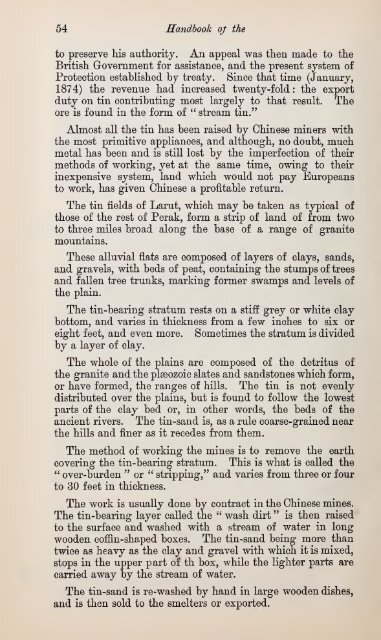Handbook of the federated Malay states - Sabrizain.org
Handbook of the federated Malay states - Sabrizain.org
Handbook of the federated Malay states - Sabrizain.org
Create successful ePaper yourself
Turn your PDF publications into a flip-book with our unique Google optimized e-Paper software.
54 <strong>Handbook</strong> oj <strong>the</strong><br />
to preserve his authority. An appeal was <strong>the</strong>n made to <strong>the</strong><br />
British Grovernment for assistance, and <strong>the</strong> present system <strong>of</strong><br />
Protection estahlished by treaty. Since that time (January,<br />
1874) <strong>the</strong> revenue had increased twenty-fold: <strong>the</strong> export<br />
duty on tin contributing most largely to that result. The<br />
ore is found in <strong>the</strong> form <strong>of</strong> " stream tin."<br />
Almost all <strong>the</strong> tin has been raised by Chinese miners with<br />
<strong>the</strong> most primitive appliances, and although, no doubt, much<br />
metal has been and is still lost by <strong>the</strong> imperfection <strong>of</strong> <strong>the</strong>ir<br />
methods <strong>of</strong> working, yet at <strong>the</strong> same time, owing to <strong>the</strong>ir<br />
inexpensive system, land which would not pay Europeans<br />
to work, has given Chinese a pr<strong>of</strong>itable return.<br />
The tin fields <strong>of</strong> Larut, which may be taken as typical <strong>of</strong><br />
those <strong>of</strong> <strong>the</strong> rest <strong>of</strong> Perak, form a strip <strong>of</strong> land <strong>of</strong> from two<br />
to three miles broad along <strong>the</strong> base <strong>of</strong> a range <strong>of</strong> granite<br />
mountains.<br />
These alluvial flats are composed <strong>of</strong> layers <strong>of</strong> clays, sands,<br />
and gravels, with beds <strong>of</strong> peat, containing <strong>the</strong> stumps <strong>of</strong> trees<br />
and fallen tree trunks, marking former swamps and levels <strong>of</strong><br />
<strong>the</strong> plain.<br />
The tin-bearing stratum rests on a stiff grey or white clay<br />
bottom, and varies in thickness from a few inches to six or<br />
eight feet, and even more. Sometimes <strong>the</strong> stratum is divided<br />
by a layer <strong>of</strong> clay.<br />
The whole <strong>of</strong> <strong>the</strong> plains are composed <strong>of</strong> <strong>the</strong> detritus <strong>of</strong><br />
<strong>the</strong> granite and <strong>the</strong> plseozoic slates and sandstones which form,<br />
or have formed, <strong>the</strong> ranges <strong>of</strong> hills. The tin is not evenly<br />
distributed over <strong>the</strong> plains, but is found to follow <strong>the</strong> lowest<br />
parts <strong>of</strong> <strong>the</strong> clay bed or, in o<strong>the</strong>r words, <strong>the</strong> beds <strong>of</strong> <strong>the</strong><br />
ancient rivers. The tin-sand is, as a rule coarse-grained near<br />
<strong>the</strong> hills and finer as it recedes from <strong>the</strong>m.<br />
The method <strong>of</strong> working <strong>the</strong> mines is to remove <strong>the</strong> earth<br />
covering <strong>the</strong> tin-bearing stratum. This is what is called <strong>the</strong><br />
" over-burden " or " stripping," and varies from three or four<br />
to 30 feet in thickness.<br />
The work is usually done by contract in <strong>the</strong> Chinese mines.<br />
The tin-bearing layer called <strong>the</strong> " wash dirt " is <strong>the</strong>n raised<br />
to <strong>the</strong> surface and washed with a stream <strong>of</strong> water in long<br />
wooden c<strong>of</strong>iin-shaped boxes. The tin-sand being more than<br />
twice as heavy as <strong>the</strong> clay and gravel with which it is mixed,<br />
stops in <strong>the</strong> upper part <strong>of</strong> th box, while <strong>the</strong> lighter parts are<br />
carried away by <strong>the</strong> stream <strong>of</strong> water.<br />
The tin-sand is re-washed by hand in large wooden dishes,<br />
and is <strong>the</strong>n sold to <strong>the</strong> smelters or exported.

















